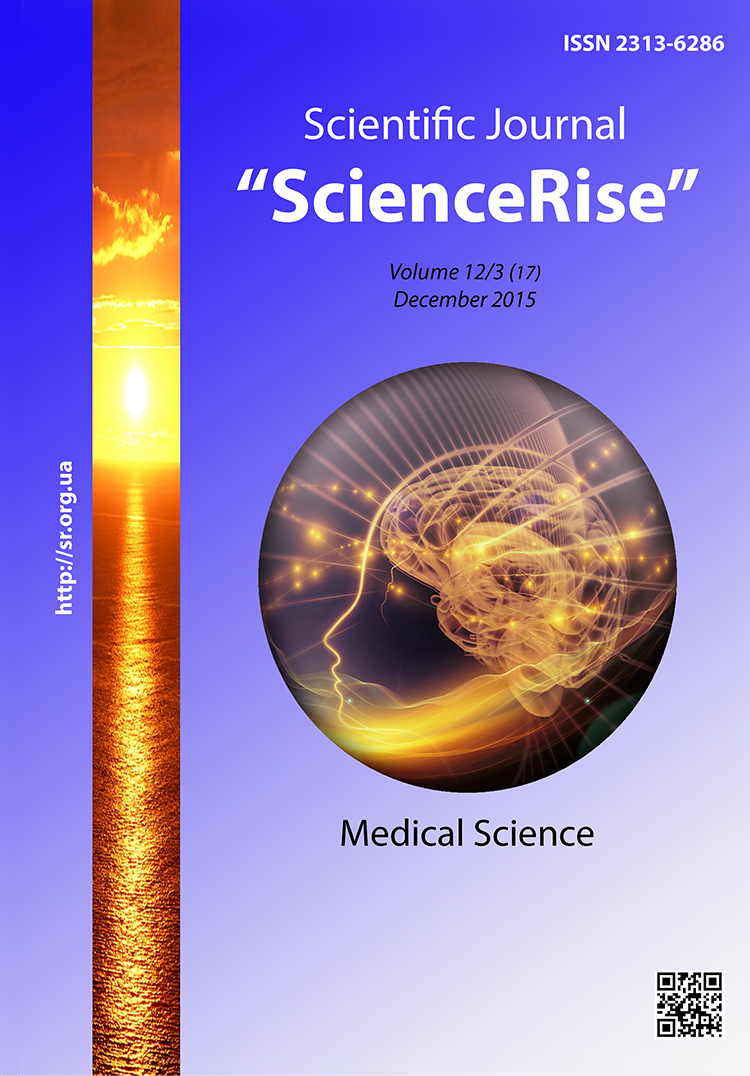Клініко-типологічний підхід до прогнозування особливостей перебігу рекурентного депресивного розладу
DOI:
https://doi.org/10.15587/2313-8416.2015.57235Ключові слова:
рекурентний депресивний розлад, клініка, перебіг, етапи, фази, ремісії, нейромедіатори, варіанти, прогнозАнотація
Виявлено можливість визначення прогнозу перебігу рекурентного депресивного розладу (РДР) за допомогою дослідження преморбіду, віку захворювання, тривалості початкового та кінцевого етапів, кількості та тривалості фаз та ремісій на цих етапах, особливості синдромодинаміки. За даними захворювання слід віднести чотирі варіанта перебігу. Прогноз здійснюється шляхом співставлення показників перебігу захворювання пацієнта з визначеними термінами зміни етапів перебігу
Посилання
Pidkorytov, V. S. (2010). Current approachesto the treatment of"pharmaco-resistant" depression. Kharkiv: Visnik of Ukrainian neuropsychiatrist. 18 (2), 55–57.
Simon, G. E. (2000). Long-term prognosis of depression in primary care. Bull. WHO, 78 (4), 439–445.
Dikaya, T. I. (2004). On the issue of long-term multi-year depression: clinical and psychopathological features and differentiation of prolonged depression. Scientific journal Psychiatry, 4, 48–54.
Dikaya, T. I. (2004). Long-term long-term depression in the form of chronic depression: clinical and psychopathological and dynamic aspects. Scientific journal Psychiatry, 5, 26–34.
Dikaya, T. I. (2006). Prolonged and chronic endogenous depression (history of formation of the concept, content and clinical nosology evaluation): a review of litas. Scientific journal Psychiatry, 1, 49–58.
Dikaya, T. I. (2011). Clinical andpsychopathologicalfeatures anddynamic aspects ofprotractedand chronicendogenous depression. Visnik of the Russian Academy of Medical Sciences, 4, 19–25.
Krasnov, V. N. (2011). Affective spectrumdisorders. Moscow: The practice of medicine, 432.
Marneros, A., Akiskal, H. S., Angst, J., Brimarher, B. et. al. (2004). Das neurHandbuch der Bipolaren und Depressive Erkrankunen. Stuttgard; New York: Georg ThiemeVerlag, 781.
Vertogradova, O. P., Petuhov, V. (2005). Prolonged depression (laws of formation, prognosis, therapy). Social and clinical psychiatry, 4, 18–22.
Podkorytov, B. C. (2002). Depression and resistance. Journal of Psychiatry and Medical Psychology, 1, 118–124.
Mazo, E. G. (2008). Тreatment-resistant depression: current approaches to diagnosis and treatment. St. Petersburg: Bulletin of St. University, 2, 87–96.
Ivanov, M. V. (2008). Negative and cognitive disorders in endogenous psychoses: diagnostics, clinic, therapy. St. Petersburg: Univ NIPNI them. V. M. Behterev ondylitis, 288.
Smulevich, A. B. (2001).Depression in general medicine: A Guide for Physicians. Moscow: Med. Inf. Agency, 256.
Smulevich, A. B. (2003). Depression in somatic and mental illnesses. Moscow: Med. Inf. Agency, 432.
Maruta, N. O., Mіshiev, V. D. (2001). Suchasnі forms depresivni rozladі. Archive of psihіatrіi, 4, 76–80.
Murphy, J. M., Laird, N. M., Monson, R. R., Sobol, A. M., Leighton, A. H. (2000). A 40-Year Perspective on the Prevalence of Depression. Archives of General Psychiatry, 57 (3), 209–215. doi: 10.1001/archpsyc.57.3.209
Fava, M. (2003). Diagnosis and definition of treatment-resistant depression. Biological Psychiatry, 53 (8), 649–659. doi: 10.1016/s0006-3223(03)00231-2
Smulevich, A. B. (2002). Prolonged treatment-resistant endogenous depression. Psychiatry andpsychopharmacology, 4, 128–132.
Baybarak, N. A. (2012). Clinical and typological variations recurrent depressive disorder with long-term course. Ukrainian Journal neuropsychiatrist, 1 (70), 34–39.
##submission.downloads##
Опубліковано
Номер
Розділ
Ліцензія
Авторське право (c) 2015 Наталя Анатоліївна Байбарак

Ця робота ліцензується відповідно до Creative Commons Attribution 4.0 International License.
Наше видання використовує положення про авторські права Creative Commons CC BY для журналів відкритого доступу.
Автори, які публікуються у цьому журналі, погоджуються з наступними умовами:
1. Автори залишають за собою право на авторство своєї роботи та передають журналу право першої публікації цієї роботи на умовах ліцензії Creative Commons CC BY, котра дозволяє іншим особам вільно розповсюджувати опубліковану роботу з обов'язковим посиланням на авторів оригінальної роботи та першу публікацію роботи у цьому журналі.
2. Автори мають право укладати самостійні додаткові угоди щодо неексклюзивного розповсюдження роботи у тому вигляді, в якому вона була опублікована цим журналом (наприклад, розміщувати роботу в електронному сховищі установи або публікувати у складі монографії), за умови збереження посилання на першу публікацію роботи у цьому журналі.

